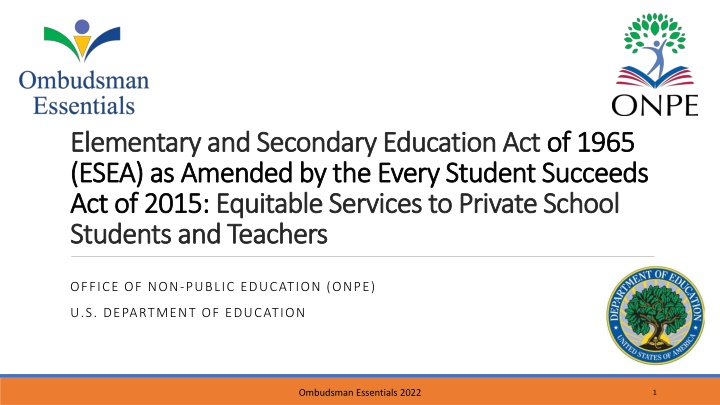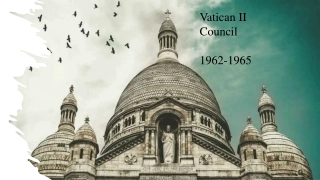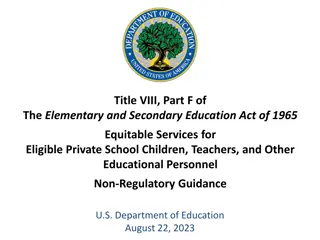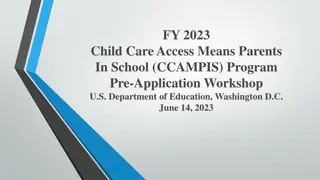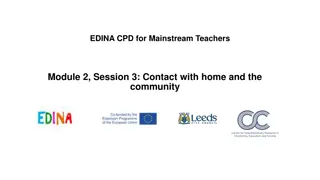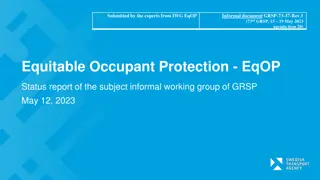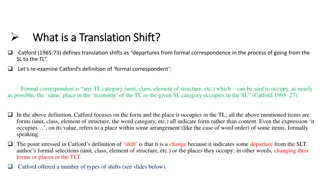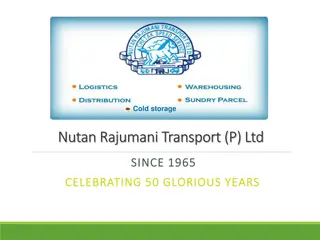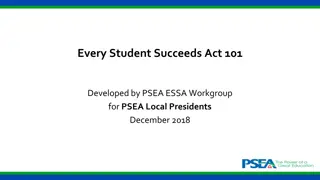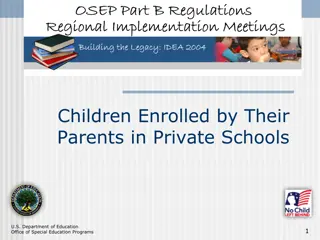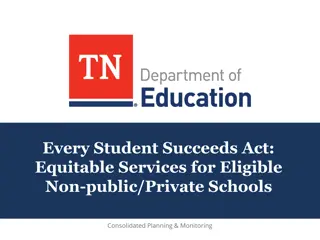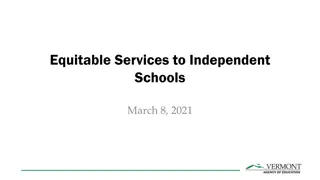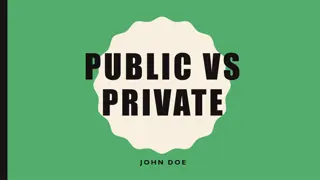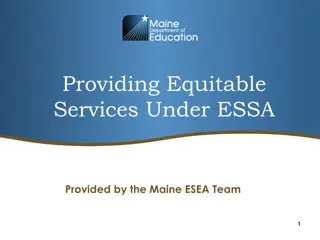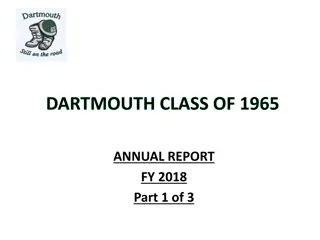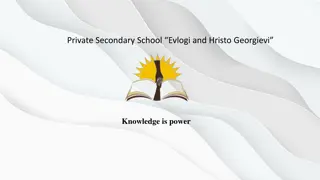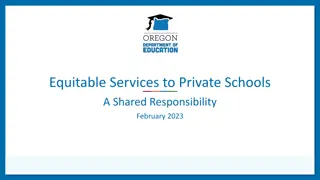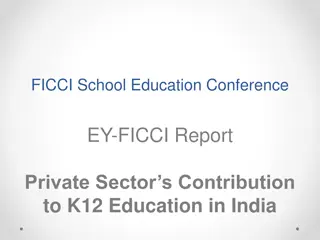Education Act of 1965 and Equitable Services for Private School Students
The Elementary and Secondary Education Act (ESEA) of 1965, as amended by the Every Student Succeeds Act in 2015, ensures equitable participation of private school students and teachers in federal education programs. The Office of Non-Public Education (ONPE) oversees this initiative, providing resources and guidance to facilitate private school involvement. Key points include consultation, funding control, and the requirement of services to be secular, neutral, and supplemental. An ombudsman is designated to monitor equitable service requirements.
Download Presentation

Please find below an Image/Link to download the presentation.
The content on the website is provided AS IS for your information and personal use only. It may not be sold, licensed, or shared on other websites without obtaining consent from the author.If you encounter any issues during the download, it is possible that the publisher has removed the file from their server.
You are allowed to download the files provided on this website for personal or commercial use, subject to the condition that they are used lawfully. All files are the property of their respective owners.
The content on the website is provided AS IS for your information and personal use only. It may not be sold, licensed, or shared on other websites without obtaining consent from the author.
E N D
Presentation Transcript
Elementary and Secondary Education Act Elementary and Secondary Education Actof 1965 (ESEA) as Amended by the Every Student Succeeds (ESEA) as Amended by the Every Student Succeeds Act of 2015: Act of 2015:Equitable Services to Private School Equitable Services to Private School Students and Teachers Students and Teachers of 1965 OFFICE OF NON-PUBLIC EDUCATION (ONPE) U.S. DEPARTMENT OF EDUCATION Ombudsman Essentials 2022 1
Office of Non-Public Education (ONPE) Mission To facilitate maximum participation of private school students and teachers in federal education programs and initiatives. Ombudsman Essentials 2022 2
ONPE Webpage Resources https://www2.ed.gov/about/inits/ed/non-public-education/index.html Ombudsman Essentials 2022 3
ESEA Equitable Services: Six Key Points 1. In key ESEA programs, the law provides for equitable participation of private school students, teachers and other educational personnel, and, in some cases, families. 4. A public agency must control funds. Private schools do not receive funds. 5. Services must be secular, neutral, and non-ideological; supplemental; and costs must be allowable, necessary, and reasonable. 2. Consultation must be timely and meaningful. 6. Private school officials have the right to file a formal complaint. 3. Funds generated for equitable services must be equal on a per-pupil basis. Ombudsman Essentials 2022 4
ESEA Ombudsman To help ensure that private school children, teachers, and other educational personnel receive services equitable to those in public schools, an SEA must designate an ombudsman to monitor and enforce Title I and Title VIII equitable services requirements. ESEA Sections 1117(a)(3)(B) and 8501(a)(3)(B) Ombudsman Essentials 2022 5
Key Point #1: Equitable Participation The ESEA requires local educational agencies (LEAs) and other eligible entities (hereafter referred collectively as LEAs) to provide for the equitable participation of private school students, teachers and other educational personnel, and, in some cases, families in some of the ESEA s major programs. ESEA sections 1117 and 8501 Ombudsman Essentials 2022 6
Title I, Part A Title I, Part A: Improving Basic Programs Operated by Local Educational Agencies Ensures all children have a fair, equal, and significant opportunity to obtain a high-quality education; and Provides equitable services to private school students to improve the achievement of students who are failing or most at risk of failing to meet challenging academic achievement standards and who reside in participating public school attendance areas with high concentrations of students from low-income families. Ombudsman Essentials 2022 7
Title VIII: Equitable Services Provisions Under the ESEA, the Title VIII equitable services provisions cover the following programs: Title I, Part C - Education of Migratory Children Title II, Part A - Supporting Effective Instruction Title III, Part A - English Language Acquisition, Language Enhancement, and Academic Achievement Title IV, Part A - Student Support and Academic Enrichment Grants Title IV, Part B - Nita M. Lowey 21st Century Community Learning Centers Title IV, Part F, Section 4631 - Project SERV ESEA section 8501(b) Ombudsman Essentials 2022 8
Equitable Services Defined The LEA: Assesses, addresses and evaluates the needs of private school students and teachers; Provides benefits and services that meet the needs of private school students and teachers; Determines an equal amount of funds on a per student basis to provide equitable services; and Provides private school students and teachers with an opportunity to participate in activities equitable to the opportunity provided public school students and teachers. Ombudsman Essentials 2022 9
Key Point #2: Consultation An LEA is required to consult with private school officials regarding the provision of equitable services. Consultation must occur during the design, development, and implementation of the respective program. Consultation must occur before the LEA makes any decision that affects the opportunity of eligible private school students and teachers to participate and must continue throughout the implementation and assessment of services. ESEA sections 1117(b)(3) and 8501(c)(3) Ombudsman Essentials 2022 10
Consultation Meaningful consultation provides a genuine opportunity for all parties to express their views, and to have their views seriously considered. Timely consultation provides adequate notice to private school officials. Successful consultation establishes positive and productive working relationships. ESEA sections 1117(b) and 8501(c) Ombudsman Essentials 2022 11
Consultation Written Affirmation of Consultation Required Needs of Private School Students and Teachers Pooling of Funds Size and Scope of Services Amount of Funds Available for Services and How the Amount Is Determined Providing Services Directly or Via Another Entity How, Where, When and By Whom Services Are Provided How and When Decisions are Made Use of 3rd Party Provider and Written Explanation for Not Using 3rd Party Provider Assessment of Services Ombudsman Essentials 2022 12
Consultation An offer of services by an LEA without an opportunity for timely and meaningful consultation with private school officials does not meet the requirement of the law. Ombudsman Essentials 2022 13
Consultation: Goal of Agreement The goal of consultation is agreement between the LEA and appropriate private school officials on how to provide equitable and effective programs for eligible private school children. ESEA sections 1117(b)(1) and 8501(c)(1) Ombudsman Essentials 2022 14
Documentation of Consultation Each LEA shall maintain in the agency s records, and provide to the State educational agency (SEA) involved, a written affirmation signed by officials of each participating private school that the meaningful consultation has occurred. The written affirmation shall provide the option for private school officials to indicate such officials belief that timely and meaningful consultation has not occurred or that the program design is not equitable with respect to eligible private school children. If private school officials do not provide an affirmation within a reasonable period of time, the LEA shall forward documentation that consultation has, or attempts at consultation have, taken place. ESEA sections 1117(b)(5) and 8501(c)(5) Ombudsman Essentials 2022 15
Sample Resource: Consultation Timeline Month LEA Activity Begin programs and services. Consult with private school officials about current programs and services implementation and modify as necessary. September Continue consultation about current programs and services implementation. October Consult with private school officials about the status of current programs and services. Obtain complete list of all private schools with appropriate contact names for later use in mailing Intent to Participate in Federal Education Programs forms. November - December Continue consultation with private school officials about the status of current programs and services. Send Intent to Participate forms to all private schools in the LEA with a February deadline for returning the forms. January Continue consultation with private school officials about the status of current programs and services. Conduct a district-wide consultation meeting with all private school officials and provide a general overview of programs that will be available to their students and teachers in the next school year. Provide private school officials with planning document to prepare them for consultation about next year s programs and services. Consult with private school officials to identify students and teachers needs, discuss services and estimated funding figures, design programs, and establish priorities for the next school year. February - March Continued on next slide Ombudsman Essentials 2022 16
Sample Resource: Consultation Timeline (continued) Continued from previous slide Month LEA Activity Evaluate programs and services for the current school year and make suggestions for modifying programs that will be implemented again in the next school year. Continue consultation and planning for programs and services for next school year. Complete plans for programs and services and set dates for when they will begin in the next school year. Develop consultation timeline for the next school year. April - May Finalize actions related to programs and services. June Inform private school officials about the readiness of programs and services for the upcoming school year. Provide programs funding figures or estimates to private school officials for upcoming school year. July - August Ombudsman Essentials 2022 17
Key Point #3: Equitable Share Educational services and other benefits provided to private school students and educators must be equitable in comparison to the benefits for public school students and educators. ESEA sections 1117(a)(3)(A) and 8501(a)(3)(A) Ombudsman Essentials 2022 18
Equitable Share: Title I, Part A Title I Proportional Share An LEA must determine the proportional share of Title I funds available for equitable services based on the total amount of Title I funds received by the LEA prior to any allowable expenditures or transfers of funds: 1. Determine the total number of children from low-income families residing in each participating public school attendance who attend public and private schools. 2. Determine the overall proportion of these children who attend private schools. 3. Based on this proportion, determine the amount of funds available for equitable services based on that proportion of the LEA s total Title I allocation. ESEA section 1117(a)(4)(A) Ombudsman Essentials 2022 19
Equitable Share: Title VIII Title VIII Equitable Share Expenditures for services for programs for private school students and teachers must be equal to those of public school students on a per-pupil basis, taking into account the number and the educational needs of childrento be served. ESEA section 8501(a)(4)(A) Ombudsman Essentials 2022 20
Notice of Allocation for Equitable Services An SEA must provide notice in a timely manner to appropriate private school officials in the State of the allocation of funds for educational services and other benefits under each ESEA program that an LEA has determined are available for eligible private school children, teachers and other educational personnel, and families. ESEA sections 1117(a)(4)(C) and 8501(a)(4)(C) Ombudsman Essentials 2022 21
Student Eligibility: Title I, Part A Child resides in a Title I participating public school attendance area, attends a private school, AND is identified by the LEA as: Low achieving on the basis of multiple, educationally related, objective criteria; or Homeless, in the prior 2 years participated in Head Start, a literacy program under Title II, a Title I preschool program, or Title I, Part C, or is a child in a local institution or community day program for neglected or delinquent children. ESEA sections 1115(c)(1)(B) and 1117(a)(1) Ombudsman Essentials 2022 22
Student Eligibility: Title VIII Students enrolled in private schools located in the area served by the ESEA program are eligible to participate. May be restricted based on the purpose of the ESEA program (ex. Title III, Part A). Where funding and resources may limit the number of children who can participate in the program, LEAs must consult with private school officials on this matter. ESEA sections 8501(a)(1) and 8501(b)(2) Ombudsman Essentials 2022 23
School Choice Participation in a Federal or State private school choice program does not affect a private school student s eligibility for equitable services under an ESEA program. Regardless of the source of funds paying a private school student s tuition, a student is eligible for equitable services under the ESEA if the student meets the eligibility requirements of the respective program. Ombudsman Essentials 2022 24
Key Point #4: LEAs Responsibility An LEA remains in control of the federal funds and maintains title to materials, equipment and property purchased with such funds. ESEA sections 1117(d)(1) and 8501(d)(1) Ombudsman Essentials 2022 25
Key Point #5: Characteristics of Services Services, materials, and equipment must be secular, neutral, and non-ideological. Services must be supplemental in nature; they may not supplant what the private school would otherwise provide absent the federal education services. The services must be allowable, reasonable, and necessary in meeting the needs of private school students and teachers. ESEA sections 1117(a)(2) and 8501(a)(2); 34 CFR 299.8; and 2 CFR Part 200. Ombudsman Essentials 2022 26
Key Point #6: Formal Complaint Private school officials, or any interested party, have the right to file a formal written complaint with an SEA if they believe that timely and meaningful consultation has not occurred, the LEA did not give due consideration to the views of the private school officials, or that equitable services have not been provided. ESEA sections 1117(b)(6) and 8501(c)(6) Ombudsman Essentials 2022 27
Formal Complaint (continued) A formal written complaint must be addressed to the SEA and include: A statement that the LEA has violated a requirement of a federal statute or regulation that applies to a program requiring equitable participation; The facts on which the statement is based and the specific statutory or regulatory requirement allegedly violated; and The signature of the complainant. 34 C.F.R. 299.11-299.13 Ombudsman Essentials 2022 28
Guidance and Resources Non-Regulatory Guidance: Fiscal Changes and Equitable Services Requirements ESEA Title I Part A Equitable Services Non-regulatory Guidance (October 2019) DRAFT ESEA Title VIII Equitable Services Non-regulatory Guidance (March 2022) ESEA State Ombudsman Corner ESEA State Ombudsman Directory ONPE website Ombudsman Essentials 2022 29
Contact Info Office of Non-Public Education onpe@ed.gov 202-401-1365 https://www2.ed.gov/about/inits/ed/non-public-education/index.html Ombudsman Essentials 2022 30
